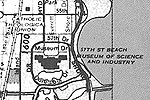
South Lakefront
In the period just before the Civil War, Chicago's upper middle
class began to look toward the south lakefront below 47th Street
for a possible suburban refuge and for summer homes. While most
of the very rich were settling on Prairie Avenue to the north,
others were starting to be attracted to Hyde Park, Kenwood, and
South Shore. The turning point for the area was the decision of
the Illinois Central Railroad in the inid-1850s to run a commuter
line south from downtown along the lakefront.
These areas soon prospered as the white Anglo-Saxon Protestant
middle class came in search of a refuge from an increasingly crowded
working-class Irish and German city. All of the South Side below
39th Street remained a suburb of Chicago until the annexation
of 1889. The residents of the south lakefront from 47th to 79th
Street generally opposed this "surrender" to Chicago,
but their working-class neighbors overruled them just before the
World's Fair of 1893.
The World's Columbian Exposition in Jackson Park had a tremendous
Impact on these lakefront neighborhoods. It greatly affected the
residential development of Hyde Park, Kenwood, and South Shore.
It also changed the character of Hyde Park. Storefronts, hotels,
and outsiders suddenly appeared everywhere in the once quiet suburb.
Another fundamental change also came in 1893 when the University
of Chicago opened its doors just north of the Midway Plaisance.
The fair and the university both shaped the early history of the
south lakefront.
Still more demographic and economic changes came in the twentieth
century. The ethnic middle class, originally Jewish and Irish,
followed the Anglo-Saxon Protestants to the lakefront. By mid-century
blacks joined them. The urban renewal programs of the 1950s and
1960s were a response to demographic and economic change, as much
of the old middle class left the area.
Today all three of these community areas, Hyde Park, Kenwood,
and South Shore, are racially integrated, at least to some degree.
The Hyde Park-Kenwood area is the largest, most stable integrated
area in Chicago and perhaps in the country. And yet the success
of Hyde Park's integration and stability was purchased at quite
a price. To a large extent Hyde Park remains a middle-class enclave
as it was in the nineteenth century. Racial integration has proved
to be less successful in South Shore where the white middle class
tends to locate along the lakefront and in the Jackson Park Highlands.
The entire area south of 47th Street remains attractive to both
black and white middle-class people, especially those interested
in historic preservation.
1
of 23
next
»
|
 |

|
 |
 
Map of South
Lakefront. »
|